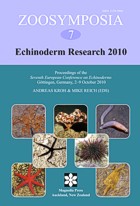Abstract
Six spatangoid species living in an area about 1 km2 at depths of 5–18 m were investigated in the Oki-Islands in the Japan Sea. The spatangoids capable of burrowing deeply principally adapt to unstable environment where the sediment surface is disturbed by storms. They are confined to the respective habitats depending on their functional morphology; apical tuft spines and fascioles for respiration, inflated plastron and stern-like postero-ventral shape for deep-burrowing. An exceptional spatangoid, Lovenia elongata, has specific morphologies for quick burrowing and rapid righting against disturbance of superficial sediment, which make it possible for it to live in fine- to coarse-grained sand at various water depths in spite of its burrowing just below the sediment surface.

